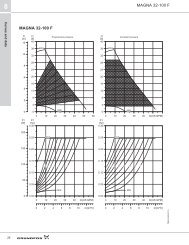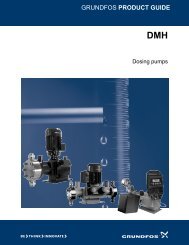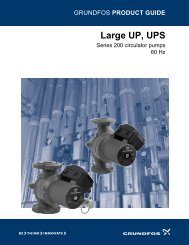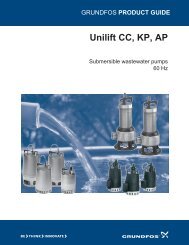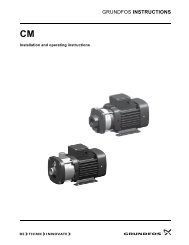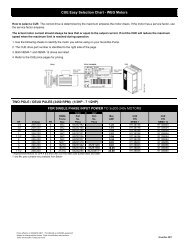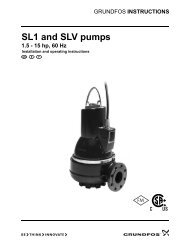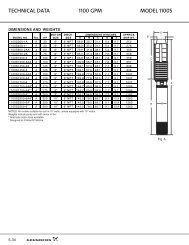You also want an ePaper? Increase the reach of your titles
YUMPU automatically turns print PDFs into web optimized ePapers that Google loves.
10<br />
<strong>Grundfos</strong> E-<strong>pumps</strong><br />
Advanced use of MLE motors<br />
Operating conditions for the stop function<br />
A pressure sensor, a non-return valve, and a<br />
diaphragm tank are required for the stop function to<br />
operate properly.<br />
Note: The non-return valve must always be installed<br />
before the pressure sensor. See fig. 76 and fig. 77.<br />
Fig. 76 Position of the non-return valve and pressure<br />
sensor in system with suction lift operation<br />
Pump<br />
Pressure sensor<br />
Pump<br />
Non-return valve<br />
Pressure sensor<br />
Diaphragm tank<br />
Diaphragm tank<br />
Fig. 77 Position of the non-return valve and pressure<br />
sensor in system with positive inlet pressure<br />
When low flow is detected, the pump is in on/off<br />
operation. If there is flow, the pump will continue<br />
operating according to the setpoint. See fig. 78.<br />
Stop pressure<br />
∆H<br />
Start pressure<br />
Non-return valve<br />
On/off operation<br />
Continuous operation<br />
Fig. 78 Constant pressure with stop function.<br />
Differenc between start and stop pressures (∆H)<br />
Diaphragm tank<br />
The stop function requires a diaphragm tank of a<br />
certain minimum size. The tank must be installed near<br />
the discharge of the pump, and the precharge air<br />
pressure must be 0.7 x setpoint.<br />
TM03 8582 1907<br />
TM03 8583 1907<br />
TM03 8477 1607<br />
Recommended diaphragm tank size:<br />
Rated flow of pump<br />
[gpm (m 3 h)]<br />
0 - 26<br />
(0 - 5.9)<br />
27 - 105<br />
(6.1 - 23.8)<br />
106 - 176<br />
(24.2 - 40)<br />
177 - 308<br />
(40.2 - 70.0)<br />
309 - 440<br />
(70.2 - 99.9)<br />
441 - 750<br />
(100 - 170)<br />
CRE pump<br />
Typical diaphragm<br />
tank size [gal (liter)]<br />
1s, 1, 3 2 (7.6)<br />
5, 10, 15 4.4 (16.7)<br />
20, 32 14 (53.0)<br />
45 34 (128.7)<br />
64, 90 62 (234.7)<br />
120, 150 86 (325.5)<br />
If a diaphragm tank of the above size is installed in the<br />
system, no additional adjustment should be necessary.<br />
If the tank installed is too small, the pump will start and<br />
stop often. Tank size will influence at which flow the<br />
system will go into start/stop operation.<br />
Description<br />
The low-flow stop function can operate in two different<br />
ways:<br />
• by means of an integrated "low-flow detection<br />
function"<br />
• by means of an external flow switch connected to<br />
the digital input.<br />
Low-flow detection function<br />
• The low-flow detection function will check the flow<br />
regularly by reducing the speed for a short time. A<br />
small change in pressure or no change in pressure<br />
means that there is low flow.<br />
Low-flow detection with flow switch<br />
• When a flow switch detects low flow, the digital input<br />
will be activated.<br />
Contact <strong>Grundfos</strong> for further information.<br />
Dry-running protection<br />
This function protects the pump against dry running.<br />
When lack of inlet pressure or water shortage is<br />
detected, the pump will be stopped before being<br />
damaged.<br />
Lack of inlet pressure or water shortage can be<br />
detected with a switch connected to a digital input<br />
configured to dry-running protection.<br />
The use of a digital input requires an accessory, such<br />
as:<br />
• a <strong>Grundfos</strong> Liqtec® dry-running switch (for more<br />
information on LiqTec, see section 12. Accessories)<br />
• a pressure switch installed on the suction side of the<br />
pump<br />
• a float switch installed on the suction side of the<br />
pump.<br />
The pump cannot restart as long as the digital input is<br />
activated.<br />
68



